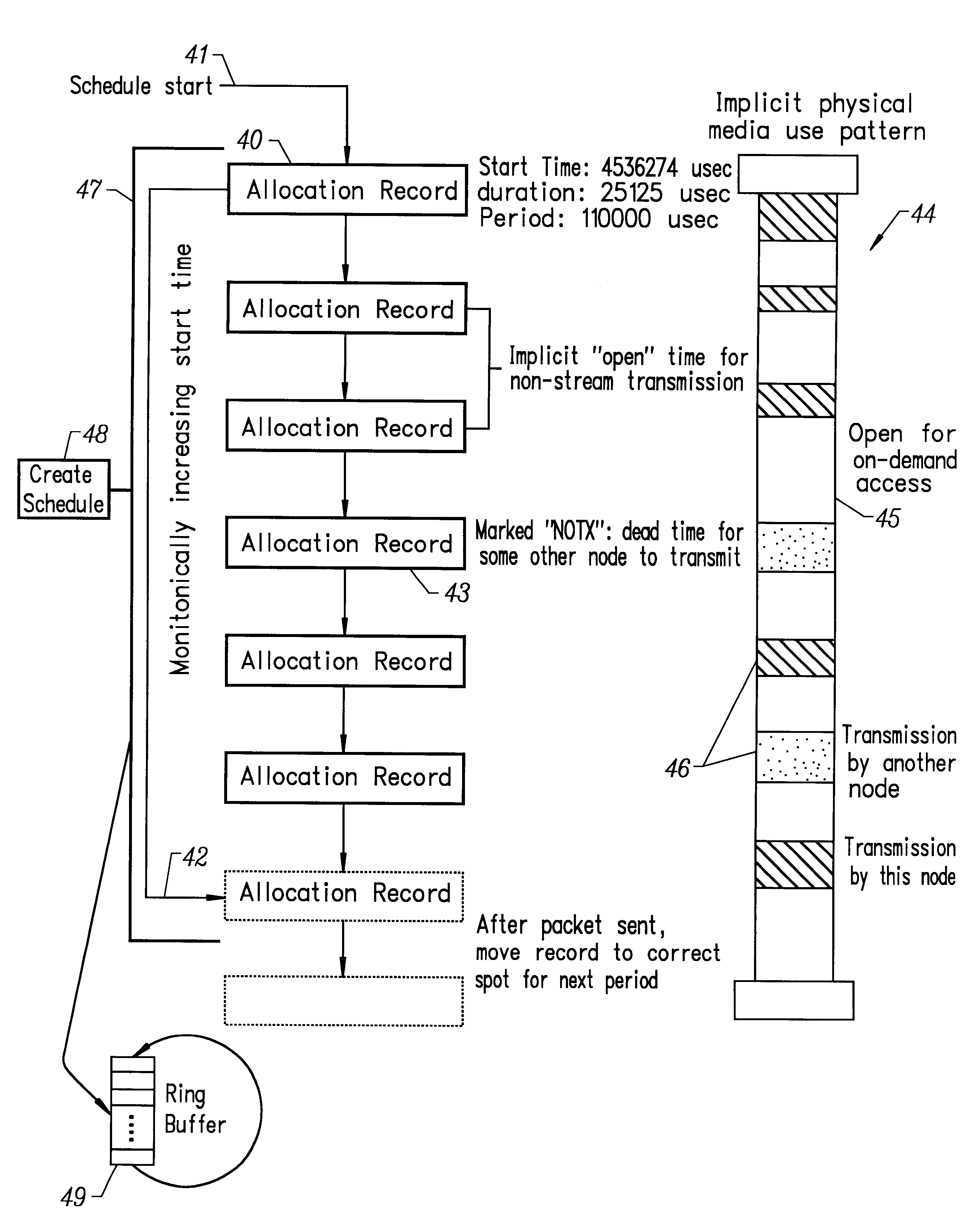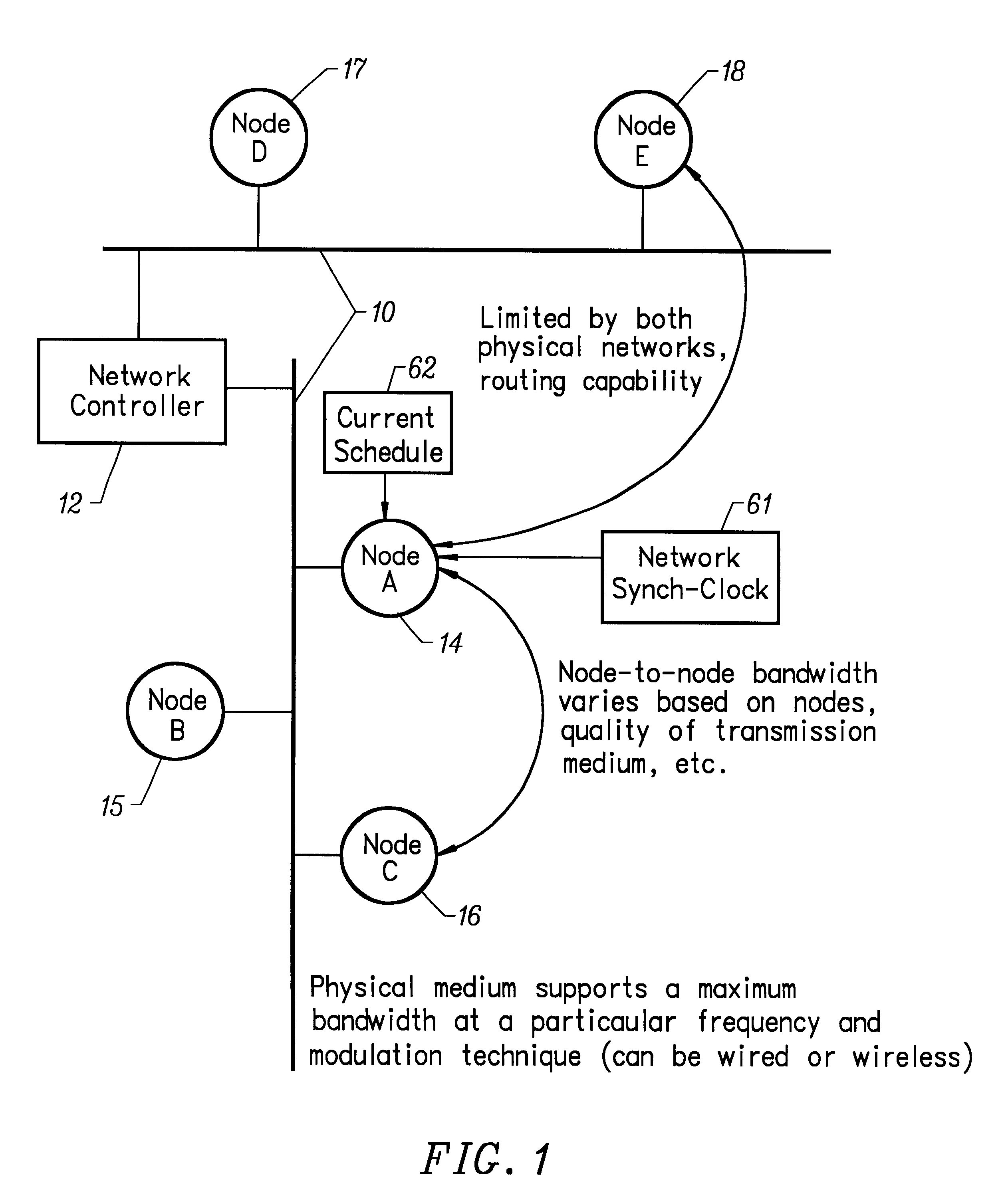Unlike previous shared-capacity networks, it is not possible to describe the maximum bandwidth of the network, or to predict a priori the achievable
data rate between any two nodes.
For example, if the audio device described earlier is two-way, the use of large buffers results in a time-shift between the incoming and outgoing streams which is easily detectable and usually annoying.
The physical cost and implementation of such buffers can become significant for inexpensive devices, such as portable phones.
However, the two types of traffic are counter-posed in requirements for the underlying network.
A serious flaw with such systems is that the bandwidth division is fixed, thus limiting both on-demand performance and the maximum bandwidth
stream that can be supported.
The usual result is inefficient utilization of the network bandwidth and limited performance.
Token passing schemes have serious weaknesses that preclude their use in many environments.
These include a requirement that all nodes have the same bandwidth to all other nodes; each node must implement complex
recovery schemes to reconstruct capacity allocations and prioritization if any node fails; each node must implement a complex suite of protocols to insure reliable operation, thus increasing the cost of a node and lowering it's reliability (from both hardware and
software failures); and passing the token through intermediate, non-transmitting nodes adds latency and decreases capacity.
Token-ring networks have fallen into technical disfavor versus
ethernet networks in many applications for these reasons.
In these methods, it is assumed that each node has sufficient capability to participate in a contention-based reservation protocol, resulting in long-term assignment of shared network capacity to particular nodes.
A general feature of these methods is the complexity of the reservation protocol, which increases the cost to implement any given node and reduces the node's reliability.
This is done to allow quick
recovery from failed nodes, but it consumes additional network bandwidth that might be more gainfully used and increases node cost.
Finally, the overall capacity of the network is lowered because it is not always possible to fill each fixed-size slot to capacity.
These schemes are not considered here because they involve proprietary techniques, specialized architectures, or hardware which is not commercially viable.
This leads to undesirable features in a simpler environment, such as a single shared
network segment: large
code size, slow setup and tear down of streams, and a requirement that every device support RSVP and all related protocols.
However, a chief flaw of RSVP in a single shared network environment is that it is a peer-to-peer protocol, and assumes intermediate routers are simply allocating and deallocating bandwidth within their
backplane and at the network ports, such that notions of total available bandwidth and managed reservations are disallowed.
In an environment where the devices share a
physical network and the bandwidth between any two devices is arbitrary, the lack of such knowledge leads to conflicts between devices.
1. The NIC incorporates a free-running counter 31 with at least
microsecond resolution, and a suitably long period. This counter may be read or modified by the
host processor at any time.
2. Various flags 32 may be set. In response to a flag 34 which may be set individually for each packet, the NIC is required to load a register 33 with a host-specified value, this register being identical in size with (1) above. The NIC is then required to wait, without accessing the transmission media, until the register value matches that of the free-running counter 51. When this occurs, the NIC must transmit the packet (except see (3)). This register is referred to as the PREWAIT register herein.
3. The host may set another flag 35 for each packet indicating that the packet itself should not be transmitted on the media. In this case, the actions of (2) above shall apply, except that when the counter values match (as determined by a
comparator 36, the NIC marks the packet done and continues on to the next packet in sequence.
4. In response to another flag 39 which may be set individually for each packet, the NIC is required to load a register 38 with a host specified value, this register being identical in size with (1) above. The NIC then transmits the packet, after waiting until the appropriate time if (2) above is active. The NIC may encounter contention for the transmission media. If the NIC is unable to send the packet before this register value matches that of the free-running counter 51, as determined by a
comparator 39, then it ceases attempting to transmit the packet, and indicates that it was not sent by setting the appropriate bit in
host memory. If case (3) is active, i.e. the packet was not to be transmitted, the NIC waits until this register matches the value of the free running counter, indicates it has finished with the packet, and continues operation. This register is referred to as the
TIMEOUT register herein.
5. The host,
on demand, may request that a packet which is waiting for transmission as described in (2) above be canceled. If transmission has not yet begun, the packet flags 37 are marked appropriately, and the NIC stops
processing packets. Otherwise, transmission of the packet is completed normally.
On a rate-adaptive network, this form of scheduling is not possible because each device may communicate at a different rate with any other given device.
Ordering of transmission of asynchronous packets from different sources may not be maintained because they vary in size, and a particular available transmission window may be too small for a given packet, which is expected behavior from an
Ethernet style network.
Reservation of on-demand bandwidth is unappealing.
The nature of on-demand bandwidth is truly bursty and demand-driven.
Dedicating bandwidth for such traffic is both wasteful and performance-limiting: wasteful because the bandwidth is mostly unused, and performance-limiting because the dedicated bandwidth is, by necessity, small.
Problems occur, however, because of the nature of CSMA / CD.
However, if a NIC is attempting to transmit an on-demand packet, and the slot has other nodes contending for it, the NIC may hold the packet past the
start time of the next scheduled packet, resulting in a schedule violation.
It is necessary that the
transmission time of the packet be allowed for during scheduling because it is not possible for a packet which has begun transmission to be canceled.
Networks are seldom static, and it is expected that nodes come and go over time for various reasons, such as node failure or power failure.
 Login to View More
Login to View More  Login to View More
Login to View More 


